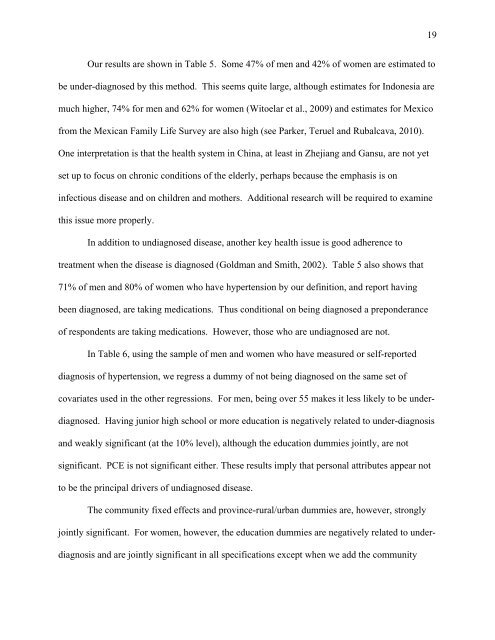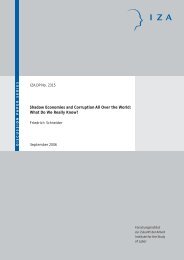Health Outcomes and Socio-Economic Status among ... - Index of - IZA
Health Outcomes and Socio-Economic Status among ... - Index of - IZA
Health Outcomes and Socio-Economic Status among ... - Index of - IZA
You also want an ePaper? Increase the reach of your titles
YUMPU automatically turns print PDFs into web optimized ePapers that Google loves.
Our results are shown in Table 5. Some 47% <strong>of</strong> men <strong>and</strong> 42% <strong>of</strong> women are estimated to<br />
be under-diagnosed by this method. This seems quite large, although estimates for Indonesia are<br />
much higher, 74% for men <strong>and</strong> 62% for women (Witoelar et al., 2009) <strong>and</strong> estimates for Mexico<br />
from the Mexican Family Life Survey are also high (see Parker, Teruel <strong>and</strong> Rubalcava, 2010).<br />
One interpretation is that the health system in China, at least in Zhejiang <strong>and</strong> Gansu, are not yet<br />
set up to focus on chronic conditions <strong>of</strong> the elderly, perhaps because the emphasis is on<br />
infectious disease <strong>and</strong> on children <strong>and</strong> mothers. Additional research will be required to examine<br />
this issue more properly.<br />
In addition to undiagnosed disease, another key health issue is good adherence to<br />
treatment when the disease is diagnosed (Goldman <strong>and</strong> Smith, 2002). Table 5 also shows that<br />
71% <strong>of</strong> men <strong>and</strong> 80% <strong>of</strong> women who have hypertension by our definition, <strong>and</strong> report having<br />
been diagnosed, are taking medications. Thus conditional on being diagnosed a preponderance<br />
<strong>of</strong> respondents are taking medications. However, those who are undiagnosed are not.<br />
In Table 6, using the sample <strong>of</strong> men <strong>and</strong> women who have measured or self-reported<br />
diagnosis <strong>of</strong> hypertension, we regress a dummy <strong>of</strong> not being diagnosed on the same set <strong>of</strong><br />
covariates used in the other regressions. For men, being over 55 makes it less likely to be under-<br />
diagnosed. Having junior high school or more education is negatively related to under-diagnosis<br />
<strong>and</strong> weakly significant (at the 10% level), although the education dummies jointly, are not<br />
significant. PCE is not significant either. These results imply that personal attributes appear not<br />
to be the principal drivers <strong>of</strong> undiagnosed disease.<br />
The community fixed effects <strong>and</strong> province-rural/urban dummies are, however, strongly<br />
jointly significant. For women, however, the education dummies are negatively related to under-<br />
diagnosis <strong>and</strong> are jointly significant in all specifications except when we add the community<br />
19
















